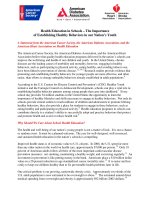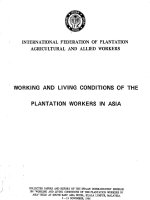ECONOMIC IMPORTANCE OF THE PLANTATION SECTOR IN KERALA pdf
Bạn đang xem bản rút gọn của tài liệu. Xem và tải ngay bản đầy đủ của tài liệu tại đây (672.58 KB, 47 trang )
CHAPTER
IV
ECONOMIC IMPORTANCE
OF
THE
PLANTATION SECTOR IN
KERALA
CHAPTER
IV
ECONOMIC IMPORTANCE OF THE
PLANTATION SECTOR IN KERALA
With nearly half the plantation area
in
the country and a major interest
in all the four crops-tea, coffee, rubber and cardamom-Kerala is
undoubtedly India's most important plantation state.' These plantations ensure
a better return to growers, higher revenue to the
Govenunent, improved income
to workers and above all the overall development of the Kerala economy.
Arnong the various categories under the non-food grain sector, plantation crops
have recorded the maximum growth in area during the period 1976-'77 to
1995-'96 as revealed by the enormous increase in their area index from 95.04
to
181.26.' Plantations are ago-industrial undertakings regularly employing a
large number of workers
and are mainly concerned with production for
comnercial purposes. With one third of Kerala's State Domestic Product (SDP)
coming from the agricultural sector, the role of plantation crops in its
;rgricultural economy may be viewed in ternls of
(i)
share
in
cultivated area;
(ii)
contribution to state agricultural income;
(iii)
share of foreign exchange earnings;
(iv)
contribution to the state's tax revenue; and
(v) employment potential.
I
IJPASI,
The Plarrtr~s' ('hrotiicle
(Coonoor. AugustISeptember
1992)
p.362
2.
UPASI,
Plarller
:s
/);rectory
(Coonoor, September
1996)
p.
1
F'lpre
4.
I
Kerala-The Important State in the Plantation Map of India
Source:
UPASI.
4.1
Share in Cultivated Area
Kerala accounts for about
46
per cent of the total area under plantations
in
~ndia.~ The crop-wise break up in terms of area and production is shown in
Table
4.1.
Table
4.1
Place of Kerala in India's Plantation Map (1995-'96)
Type of Area (Hectares) Production (Tonnes)
crop
Kerala India Kerala India
Tea
34,656 4,30,888 64,794 7,49,888
Coffee
82,348 2,92,467 40,400 2,00,000
Rubber
4,43,300 5,15,572 4.76,495 5,06,910
Cardamom
43,320 83,700 4,185 6,338
Source: (a)
State Planning Board, Government of Kerala, Thiruvananthapuram
(b)
Directorate of Economics and Statistics, Thiruvananthapuram.
It
is
evident from the table that rubber cultivation in Kerala forms
b5.98
per
cent of the total area under rubber
in
the country. Kerala's rubber production is
94
per cent of the total rubber production in India. Cardamom also occupies a
prominent place
in
the matter of area and production. Kerala accounts for
5 1.76
per cent of the area and
66
per cent of the production of cardamom
in
the
country.
Based on Table
4.1,
Figures
4.2
and
4.3
give a diagrammatic
representation of the area and production of plantation crops in Kerala
respectively
.
3.
Economic Review, op. cit.,
1997,
p.
48
Figure
4
2
Area Under Plantation Crops in India and Kerala
(1995-'96)
Tea
Coffee
Rubber
Cardamom
Type
of
crop
Source:
Table
4.1
Figure
3.3
Production
of
Plantation Crops in India and Kerala
(1995-'96)
Kerala
Tea Coffee Rubber Cardamom
Type of crop
Source:
Table
4.1
4.1.1
Share in Net Cultivated Area
Plantation crops account for about
27
per cent of
the
net cultivated area
in
eral la.^
The
details are shown
in
Table
4.2.
Table
4.2
Area under plantation crops
vis-a-vis
total cultivated area
in Kerala (area in
'000
hect.)
Year
Plantat~ons Total for Total
Plantations
Cultivated
Tea Coffee Rubber Cardamom
m
Kerala area
in
Kerala
1995-'96
35
82
443 43 603 2,263
Source: Directorate of Economics
and
Statistics, Thi~vananthapuram.
Figure
4.4
shows the area under plantation crops during the period
1990-'91
to
1995-'96.
F~gure
X
-I
Area Under Plantution Crops
-
in Kerala (1990-'91 tg 1995'94)
-
.
Tea coffee
Rubber
Cardamom Total
Type
of
Crop
Source:
Table
4.2
Among the four crops, lubber accounts for the largest share
in
the net
cultivated area in Kerala.
4.2
Contribution
to
State Agricultural Income
The State's Income fiom all the sectors in
1995-'96
is
Rs.
7,018
crores.
The contribution of agricultural sector to the state income is
Rs.
2,365
crores.
The plantation crops account for
Rs.
723.69
~rores.~
Table
4.3
shows the share of tea, coffee, rubber and cardamom in State
Agricultural Income.
Table
4.3
Share of Plantations
in
State Agricultural Income
(1995'96)
-
-
S1.
No Type of crop Percentage share in
Agricultural
SDP
1
Tea
6.4
2
Coffee
3.0
3
Rubber
18.7
4
Cardamom
2.5
Total
30.6
Source: UPASI. Coonoor
Crop-wise, rubber accounts for
18.7
per cent followed by tea
(6.4
per cent), coffee
(3
per cent) and cardamom
(2.5
per cent) in the agricultural
income of the state. Figure
4.5
provides a diagrammatic illus!~%tion of
Table
4.3
.
5.
Ibid., compliled from various tables.
Figure
4.5
Share of Plantations in State Agricultural Income
(1995-'96)
Tea Coffee
Rubber
Cardamom
Type
of
crop
Source:
Table
4.3.
4.3
Share of Foreign Exchange Earnings
All the plantation crops, except rubber, earn remarkable foreign
exchange. Rubber,
on
the
other hand, is an important import substitute. State's
export earnings from different crops are shown in Table
4.4.
Table
4.4
Contribution of Plantation Crops to the State's Foreign Exchange
Earnings
(1991-'92
to
1995-'96)
Tea
Coffee
Small
Cardamom
Year
Quantity
Value
(Rs.
Quantity
Value(in
Quantity
Value
(Tomes) lakhs) (Tomes)
Rs.
lakhs) (Tomes)
(Rs.
lu)
Source: (a) Tea Board, Calcutta.
(b)
Coffee Board, Bangalore.
(c)
Spices
Board, Kochi
Refer Figure
4.6
for a diagrammatic representation of the contribution of
plantation crops to the foreign exchange earnings of the state
in
1995.96.
re
6
Contribution
qf
Plantation Crops to the Foreign Exclrunge
Earning
of
Kerala
(1995'96)
I
Tea Coffee Cardamom
Type
of
crop
Source:
Table
4.4.
4.4
Contribution to the State's
Tax
Revenue
Contribution of plantation crops to the
state's tax revenue is an
important indicator of the
economic significance of this sector.
Table
4.5
shows the details of the Centre-State break up of the various
taxes from the Plantation sector to the State
Govenunent.
I
,A
varlety
of
taxes
;inti
duties to
the
Central and State Ciovcrnlnents are
being paid by the plantation sector. The Central Sales Tax is levied under the
Central Act and collected by the State Government. The entire amount comes
to the State Treasury.
A
portion of the Central Income Tax and Excise duty
also goes to the State Revenue. The most important areas of taxation of
Kerala
Government are (i) State Sales TdPurchase Tax (ii) Agricultural Income Tax
and
(iii) Plantation Tax.
Table
4.5
Duties and Taxes Paid
by
Plantations
Centre State
1.
Central income tax
1.
Agricultural income tax
2.
Cess under Commodity Acts
2.
Land
tax
3.
Excise duty
3.
Plantation tax
4.
Central sales tax
4.
State
sales tax/Purchase
tax
5.
Factory license fee
5.
Building tax
6.
Land cess
7.
Machinery license fee
8.
Professional tax
9.
Service tax
Source: (a)
Directorate of Economics
and
Statistics,
op
cit
(b)
UPASI,
op.
cil.
4.5
Employment in
the
Pla~itation
Sector
A
striking characteristic of plantation agriculture is that it is labour
intensive. The four crops account for about
21
per cent of the agricultural
employment
in
the state.' Table 4.6 shows that plantations
in
Kerala provide
permanent employment to over 3.6
lakh workers throughout the year.7
Table 4.6
Average daily employment in plantations in Kerala
(no.
of
persons)
(1995-'96)
Plantation
No.
of labourers
Tea
Coffee 24,385
(7)
Rubber 2,30,000
(64)
Cardamom 22,000 (6)
Total
3,60,330
Source:
(a)
State Planning Hoard,
op
ci!
(b)
UPASI,
op
cit
Fibures in parenthesis indicate the percentage
of
workers in each plantation
Based on this table, Figure 4.7 shows the percentage of average daily
employment
in
the four crops.
6.
PInn!er
's
1)irector):
011
ci!.,
7.
7.
Ibid.
I*'/gzrre
4.7
Average Dailq' l?mployment in Plantations in Kerala
(1995-'96)
23.00%
64.00%
n~ea
a
Coffee
[3
Rubber
Cardamom
Source
Table
4.6.
In Kerala, rubber plantations employ the largest number of workers
followed by tea, coffee and
cardaniom.
4.6
Plantation Crops
in
Kerala's Economy
A
study of the relative share of plantations in terms of the net cultivated
area, state domestic product, foreign exchange earnings to the country, tax
revenue and employment potential reveals the importance of this sector in
Kerala. Table
4.7
shows the sibpificance of this sector to the state's economy.
Table
4.7
Plantation Crops in Kerala's Economy
(1995-'96)
Type of Share in net Share in agric-
Share in
Share
in
cultivated area ultural SDP
country's
crop emp\oyment
export earnings
(Percentage)
Tea
1.9
6.4
6.9
4.6
Coffee
3.8 3.0
13.2
3.0
Rubber
18.7 18.7
Nil
11.7
Cardamom
2.5
2.5
80.0 1.6
All Crops
26.9
30.6
9.8
20.9
Source (a) UPASI,
op
ci/
(b)
Directorate of Economic and Statistics,
op.
crl.
Though export ea~nings from rubber is nil, its importance in our
economy is evident from the share it occupies in net cultivated area, in
agricultural
SDP
and in employment generation. Export earnings to the country
are the largest from cardamom,
i.e., 80 per cent. Coffee comes next to
cardamom
(13.2
per cent). Though the share of tea
in
net cultivated area is
only
1.9 per cent,
it
contributes substantially to agricultural
SDP
(6.4
per cent),
export earnings (6.9 per cent)
and
employment (4.6 per cent).
4.7
Growth
of
Plantations in Kerala
Tables 4.8,
4.9, 4.10
and
4.11
give details about the growth of tea,
coffee, rubber and cardamom in
telms of area and production in Kerala.
Table 4.8 and Figure
4.8
provide statistics relating to the area and
production of tea plantations in Kerala
during the period 1950-1996.
70
Table
4.8
I
Growth
of
Tea Plantations in Kerala
(1950-1996)
Year Area (Hectares) Production (Tonnes)
Source: Computed from the data published
by
(
I
)
Hutidbook
ofl'lru~la~ion
I.uct.s,
UPASI,
Coonoor, 1990
(2)
Tea Board, Calcutta.
Figure
4.8
Growth of Tea Plantations in
Kmala
(Area and Production)
(1950-1995)
-
60000
V)
a,
c
S
=
smw
S
CI
0
4
40000
2
P
Year
Source:
Table
4.8
It is evident that area under tea remains more or less static but output has
increased during the same period.
The growth of coffee plantations in Kerala is shown in Table 4.9.
The
same is shown diagramatically
in
Figure
4.9.
Table
4.9
Growth of Coffee Plantations in Kerala (1950-1996)
,
Year
Area ('000
Hectares) Production (Tonnes)
1950-'5 1 13,792 1,173
-
~
~
-
~
~~
-~
Source:
Computed
from
the
data
published by
(a)
Handbook of Plantat~on Facts, op cit.
(b)
Coffee
Board,
Bangalore
Figure
4.9
Growth of Coffee Plantations in Kerala (Area and Production)
(1
950-1 995)
Year
Source:
Table
4.9
It
is clear from the table and figure, that on the whole, area under coffee
and output
of
coffee are on an increase
in
Kerala during the period
1950-1996,
though there are slight variations.
Table
4.10
gives the iuea and production figures relating to rubber in
Kerala during the period
1955'-'56
to
1995-'96
Table
4.10
Growth of Rubber Plantations
in
Kerala
(1955-'56
to
1995-'96)
Year
Area
('000
Hectares)
Production
(Tom)
1955-'56
78,457 21,680
1960-'61
1,22,628 23,175
1965-'66
1,54,878 46,953
1970-'71
1,87,762 86,773
1975-'76
2,05,383 1.28.769
1980-'8 1 2,47,100 1,40,320
198
1
-'82 2,62,600 1.39.435
1982-33 2,78,000 1,52,662
1
1983-'84 2,94,300
1.62.212
1984-'85 3,12,000
1.72.092
1985 86 3,26,700
1,84,563
1986-'87
3,43,200 2,02,129
1987-'88 3,55,400
2,16,562
1988-'89
3,66,500
2,38,414
1989-'90
3,76,000
2,75,397
1990-'9
I
3,84,000
3,07,521
199
1
-'92 4,19,174
3,43,109
1992-'93
4,28,864 3,68,@8
1993-'94 4,37,138
4,08,311
1994-'95
4,43,300 4,42,830
1995-'96 4,43,300
4,76,495
Source: Computed
fiom
the data published
by
(a)
Handbook ofPlantatron Facts, op cit
(b)
Rubber
Board,
Kottaym.
Area under rubber plantation has shown a tremendous increase from
78,457 hectares in 1955-'56 to
4,43,300 hectares
in
1995-'96 resulting in an
increase of 465 per cent. Production also has increased from 21,680 tomes
in
1955-'56 to 4,76,495 tomes
in
1995-'96 leading to 2,098 per cent increase in
output
during the
period.
Figure
4.10 also presents the growth of area and production of rubber
in
Kerala.
Figure
-1.10
Growth of Rubber Plantations in Kerala
(1955-'56
to
1995-'96)
Year
Source:
Table
4.10
The
growth
of
cardamom plantations in
Kerala
from
1960-'61
to
1995-'96
is shown
in
Table
4.1
1.
Table
4.11
Growth
of
Cardamom Plantations in Kerala (1960-'61 to 1995'96)
Year Area
('000
Hectares) Production (Tonnes)
1989-'90
44 1,900
1990-'9
1
44 2,885
1991-'92
44 2,770
I
1992-'93
43 2,424
1993-'94
43 4,430
1994-'95
43 4.43
1
1995-'96
43 4,185
Source: Computed
from
the data published by
(a)
Ha?idhook
of
l'ltrtrlation Facts,
op
cit.
(b) Spices Board, Kochi.
It
is clear from the table that area under cardamom cultivation
has
been
increasing till 1988-'89 after which
a
decrease in area is
taking
place. There are
irregular variations
in
production figures also
during
the period 1960-'61 to
1995-'96. Figure 4.11 also reveals this.
figure
4.
11
Growth
of
Cardamom Plantations
in
Keralu
(1960-'61 to 1995-'96)
MOO
3500
Year
Source:
Table
4.1
1









